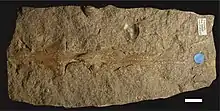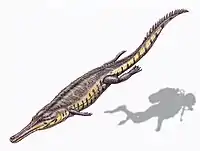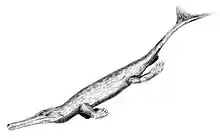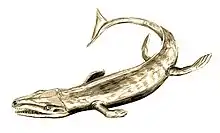Rhamphocephalus
"Rhamphocephalus" ("beak head") is an extinct genus of fossil reptile from the Middle Jurassic (Bathonian stage) Great Oolite Group of Gloucestershire, England. The name was erected as a genus of pterosaur[1] and became a 'wastebasket taxon' for British Jurassic pterosaur remains until a recent revision.[2] Rhamphocephalus comprises several named species, two of which are pterosaurian, but the type species - "R. prestwichi" - is based on remains now identified as a thalattosuchian. Because it is poorly preserved and lacks features that distinguish it from other thalattosuchians, "R. prestwichi" is considered an invalid species and the genus Rhamphocephalus is a nomen dubium.[2] Reassessments of other "Rhamphocephalus" species suggest they are also undiagnostic to species level, although they have properties allowing referral to some Jurassic pterosaur groups.[2]
| Rhamphocephalus | |
|---|---|
 | |
| Scientific classification | |
| Kingdom: | Animalia |
| Phylum: | Chordata |
| Class: | Reptilia |
| Suborder: | †Thalattosuchia |
| Genus: | †Rhamphocephalus Seeley, 1880 |
| Type species | |
| †Rhamphocephalus prestwichi (nomen dubium) Seeley, 1880 | |
Taxonomy
The type species, "R. prestwichi", is known from the skull roof fragment OUM J.28266, found the Kineton Thorns Quarry, Stow-On-Wold, Gloucestershire. Seeley (1880) noted that the cranial bones of "Rhamphocephalus" are arranged more like that of a crocodyliform rather than a pterosaur.[1] Although assigned to Pterosauria by previous authors, in their review of pterosaur remains from the Great Oolite group, O'Sullivan and Martill (2018) demonstrated that "Rhamphocephalus" belongs to Thalattosuchia rather than Pterosauria due to differences with pterosaurs in the cranial bone arrangement. They also argued that the specimen lacked good autapomorphoes and the genus was a nomen dubium.[2]
Misassigned species
Pterodactylus bucklandii von Meyer, 1832[3] and Rhamphorhynchus depressirostris Huxley, 1859,[4] both based on jaw material, were previously assigned to Rhamphocephalus, along with the nominal species Pterodactylus aclandi, P. duncani, and P. kiddi, which are based on phalangeal remains. However, the thalattosuchian reclassification of Rhamphocephalus rendered this referral untenable, although bucklandii and depressirostris were clearly pterosaurian, and P. bucklandii was assigned to Rhamphorhychinae indeterminate, while Rhamphorhynchus depressirostris was assigned to ?Scaphognathinae indeterminate.[2]
See also
References
- Seeley H.G. 1880. On Rhamphocephalus prestwichi Seeley, an Ornithosaurian from the Stonesfield Slate of Kineton. Quart. J. Geol. Soc. 36: 27-30
- Michael O’Sullivan; David M. Martill (2018). "Pterosauria of the Great Oolite Group (Bathonian, Middle Jurassic) of Oxfordshire and Gloucestershire, England". Acta Palaeontologica Polonica. Online edition. doi:10.4202/app.00490.2018.
- H. v. Meyer. 1832. Palaeologica zur Geschichte der Erde und ihrer Geschöpfe; Verlag von Siegmund Schmerber, Frankfurt am Main 1-560
- T. H. Huxley. 1859. On Rhamphorhynchus bucklandi a new pterosaurian from the Stonesfield Slate. Quarterly Journal of the Geological Society of London 15:658-670.
- Rhamphocephalus in the Paleobiology Database.



